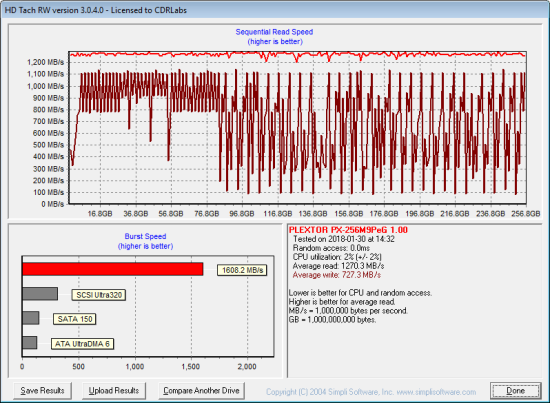TRIM Performance:
While SSD's offer many benefits, there are some downsides to using flash memory. One of the biggest issues people run into is performance degradation. Over time, an SSD will run out of fresh blocks and will have to write over data the file system has marked as deleted. This procedure is very complicated and can slow an SSD's write speeds considerably.
To fix this problem, most manufacturers have added TRIM support to their SSDs. The TRIM command allows an operating system, such as Windows 7, to tell an SSD which data blocks are no longer in use. Using this information, the drive pro-actively erases these blocks and adds them to the free block pool.

To test the M9Pe's TRIM and garbage collection functions, I first put the drive in a "dirty" state. I used Iometer to fill the entire drive and then ran a random write test for 30 minutes. Looking at the screenshot below, you can see that the M9Pe's average read and write speeds dropped to 138.1 MB/s and 429.9 MB/s, respectively.

Plextor M9Pe - Dirty
To see how well the M9Pe could recover, I let the computer sit for about 30 minutes and then reran the test. The drive's average write speed climbed up to 456.1 MB/s. However, its read speed lagged behind, averaging out at only 310.3 MB/s.

Plextor M9Pe - After TRIM
Lastly, I used Parted Magic to perform a secure erase on the M9Pe. With the drive wiped clean, it had average read and write speeds of 1,270.3 MB/s and 727.3 MB/s, respectively.

Plextor M9Pe - Secure Erased
Final Thoughts:
While not the fastest PCIe SSD to come through the 'Labs, the Plextor M9Pe delivers a lot of bang for your buck. Available with or without a heatsink, this compact, M.2 form factor SSD is powered by Marvell's 88SS1093 controller and is available with up to 1TB of Toshiba's 64-layer BiCS3 3D TLC NAND flash. Combine this with Plextor's PlexNitro technology and a PCIe Gen3 x4 NVMe 1.2 interface and you have a drive capable of delivering nearly six times the performance of your average SATA 6Gb/s SSD. In our sequential read and write tests, the 256GB version of the M9Pe was able to read at speeds as high as 3,042 MB/s and write at speeds in excess of 1,060 MB/s. The M9Pe also performed fairly well when doing random reads, but lagged behind other PCIe SSDs in our random write tests, producing less than 70,000 IOPS.
While Plextor's PlexNitro technology works well under normal workloads, it does have its limitations. If you have a heavy workload, where a consecutive write operation exceeds the size of the SLC cache, the M9Pe's write speed drops to non-accelerated levels. I also found this cache to be quite small. With the 256GB version of the M9Pe I wasn't able to write more than about 3GB worth of data before it filled and the write speed dropped below 300 MB/s. Given, this won't be an issue for the gamer looking to speed up load times, but if you have heavier workloads, you may want to consider an MLC NAND based SSD like the Plextor M8Pe.
According to Plextor, the M9Pe will be available some time March in 256GB, 512GB and 1TB capacities. The suggested retail prices are expected to range from about $110 up to $452 with the M.2 version reviewed here going for about $122.
Highs:
- Available in 256GB, 512GB and 1TB capacities
- PCIe 3.0 x4 interface with NVMe protocol
- Marvell 88SS1093 controller
- Equipped with Toshiba 64-layer BiCS3 3D TLC NAND
- Good sequential read and write performance
- PlexNitro technology optimizes performance without taking up SSD space
- Supports Plextor's True Speed technology
- M.2 2280 and HHHL PCIe form factors
- Large DRAM cache
- Reasonably priced
- 5 year warranty
Lows:
- Write speed drops when SLC cache is full
- SLC cache is small
- Lackluster random write performance
- Not supported by Plextor's PlexTool software
- Does not support hardware based encryption

